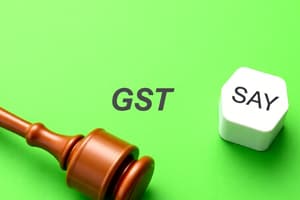Podcast
Questions and Answers
What are the four main GST slabs in India?
What are the four main GST slabs in India?
5%, 12%, 18%, and 28%
How is CGST (Central Goods and Services Tax) calculated for a GST rate of 18%?
How is CGST (Central Goods and Services Tax) calculated for a GST rate of 18%?
9%
What is the purpose of input tax credit in GST?
What is the purpose of input tax credit in GST?
To adjust the tax paid on inputs towards the output's GST liability.
What is the requirement for registered entities to be eligible for input tax credit?
What is the requirement for registered entities to be eligible for input tax credit?
How is SGST/UTGST (State Goods and Services Tax) calculated for a GST rate of 18%?
How is SGST/UTGST (State Goods and Services Tax) calculated for a GST rate of 18%?
What documentation and records are necessary to claim input tax credit?
What documentation and records are necessary to claim input tax credit?
Study Notes
GST Rate Computation and Input Tax Credit
In India's Goods and Services Tax (GST) system, correctly estimating tax liability and utilizing input tax credit effectively are critical components of successful compliance. We'll explore these aspects, especially GST rates and input tax credit, using the resources offered throughout this article.
GST Rates
Understanding GST rates is essential since they directly affect the calculation of GST liability. Indian GST consists of four main slabs with varying rates: 5%, 12%, 18%, and 28%. Additionally, compensation cess might sometimes be included depending on the nature of the goods and services involved. Important features of calculating GST for intrastate supplies are as follows:
- CGST (Central Goods and Services Tax): Rates divided by two, rounded up.
- SGST/UTGST (State Goods and Services Tax)/Compensation Cess: Same as applicable CGST rate.
For instance, the GST rate of 18% translates to CGST being 9% and the remaining 9% split between SGST/UTGST and Compensation Cess.
Input Tax Credit
Input tax credit refers to the adjustment of tax paid on inputs used in providing outputs towards the output's GST liability. Registered entities are eligible for input tax credit, assuming their suppliers have also obtained valid registrations.
To claim input tax credit, taxpayers must ensure proper documentation and maintain records. The main rules associated with input tax credit involve:
- Input tax credit cannot be claimed for capital goods unless they are used for the purpose of providing output supplies during the relevant period.
- Input tax credit can only be availed upon payment of integrated goods and services tax (IGST) or receiving credit notes issued by suppliers.
- Input tax credit claims must be supported by documentary evidence like invoices, bills, delivery receipts, shipping bills, or other specified documents.
Avoiding errors in computing GST liability and optimizing input tax credit can result in significant savings and streamlined compliance practices for taxpayers.
Studying That Suits You
Use AI to generate personalized quizzes and flashcards to suit your learning preferences.
Description
Explore the intricacies of GST rate computation and input tax credit in India's Goods and Services Tax (GST) system. Learn about the different GST rate slabs, calculation methods, input tax credit eligibility, documentation requirements, and the significance of correctly estimating tax liability.




